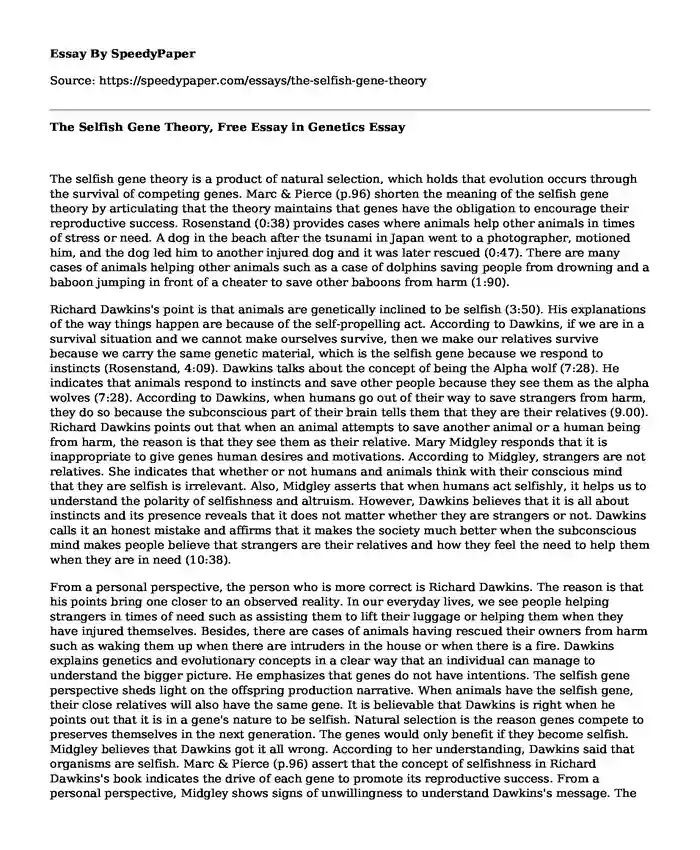The selfish gene theory is a product of natural selection, which holds that evolution occurs through the survival of competing genes. Marc & Pierce (p.96) shorten the meaning of the selfish gene theory by articulating that the theory maintains that genes have the obligation to encourage their reproductive success. Rosenstand (0:38) provides cases where animals help other animals in times of stress or need. A dog in the beach after the tsunami in Japan went to a photographer, motioned him, and the dog led him to another injured dog and it was later rescued (0:47). There are many cases of animals helping other animals such as a case of dolphins saving people from drowning and a baboon jumping in front of a cheater to save other baboons from harm (1:90).
Richard Dawkins's point is that animals are genetically inclined to be selfish (3:50). His explanations of the way things happen are because of the self-propelling act. According to Dawkins, if we are in a survival situation and we cannot make ourselves survive, then we make our relatives survive because we carry the same genetic material, which is the selfish gene because we respond to instincts (Rosenstand, 4:09). Dawkins talks about the concept of being the Alpha wolf (7:28). He indicates that animals respond to instincts and save other people because they see them as the alpha wolves (7:28). According to Dawkins, when humans go out of their way to save strangers from harm, they do so because the subconscious part of their brain tells them that they are their relatives (9.00). Richard Dawkins points out that when an animal attempts to save another animal or a human being from harm, the reason is that they see them as their relative. Mary Midgley responds that it is inappropriate to give genes human desires and motivations. According to Midgley, strangers are not relatives. She indicates that whether or not humans and animals think with their conscious mind that they are selfish is irrelevant. Also, Midgley asserts that when humans act selfishly, it helps us to understand the polarity of selfishness and altruism. However, Dawkins believes that it is all about instincts and its presence reveals that it does not matter whether they are strangers or not. Dawkins calls it an honest mistake and affirms that it makes the society much better when the subconscious mind makes people believe that strangers are their relatives and how they feel the need to help them when they are in need (10:38).
From a personal perspective, the person who is more correct is Richard Dawkins. The reason is that his points bring one closer to an observed reality. In our everyday lives, we see people helping strangers in times of need such as assisting them to lift their luggage or helping them when they have injured themselves. Besides, there are cases of animals having rescued their owners from harm such as waking them up when there are intruders in the house or when there is a fire. Dawkins explains genetics and evolutionary concepts in a clear way that an individual can manage to understand the bigger picture. He emphasizes that genes do not have intentions. The selfish gene perspective sheds light on the offspring production narrative. When animals have the selfish gene, their close relatives will also have the same gene. It is believable that Dawkins is right when he points out that it is in a gene's nature to be selfish. Natural selection is the reason genes compete to preserves themselves in the next generation. The genes would only benefit if they become selfish. Midgley believes that Dawkins got it all wrong. According to her understanding, Dawkins said that organisms are selfish. Marc & Pierce (p.96) assert that the concept of selfishness in Richard Dawkins's book indicates the drive of each gene to promote its reproductive success. From a personal perspective, Midgley shows signs of unwillingness to understand Dawkins's message. The selfish gene is just a metaphor because, in actual sense, genes do not have desires or consciousness.
France de Waal affirms that animals have morals. According to Waal, animals have empathy, cooperation, and fairness just as human beings do. From a personal perspective, his idea is sensible. Animals are rational, have moral emotions, and have reflective judgment. Cases of animals having morals have been seen worldwide. Such examples include animals who protect their owners from harm by motioning them to move away from that harm. According to Marc & Pierce (p.96), the evolution of morality is consistent with selfish genes. The authors introduce the concept of spite, where they articulate that the actor and the recipient incur reproductive costs (97). According to the authors, spite does not have any moral weight. Animals have the cognitive and emotional capacities for moral behavior as they manage to empathize and be rational in many situations (Marc & Pierce 225). From my belief, the degree of morality varies from species to species, but on the real sense, animals can manage to discern right from wrong. Besides, animals can feel emotions, which shed light on their connection with morality. Overall, animals share the same qualities as human beings because they have the same social intelligence.
Works Cited
Marc, Bekoff, & Pierce, Jessica. Wild justice: The Moral Lives of Animals. Chicago: The University of Chicago Press. 2010. Print.
Rosenstand, Nina. Rosenstand: Phil 102B, The Selfish Gene Theory. Uploaded on June 19th 2017. Accessible at https://www.youtube.com/watch?v=kcGsuhq2Zbs&t=335s&list=PL7-BFF4La5p1BdVy_ok4ixv0dq1Gde7Ea&index=5
Cite this page
The Selfish Gene Theory, Free Essay in Genetics. (2022, Aug 19). Retrieved from https://speedypaper.com/essays/the-selfish-gene-theory
Request Removal
If you are the original author of this essay and no longer wish to have it published on the SpeedyPaper website, please click below to request its removal:
Popular categories





